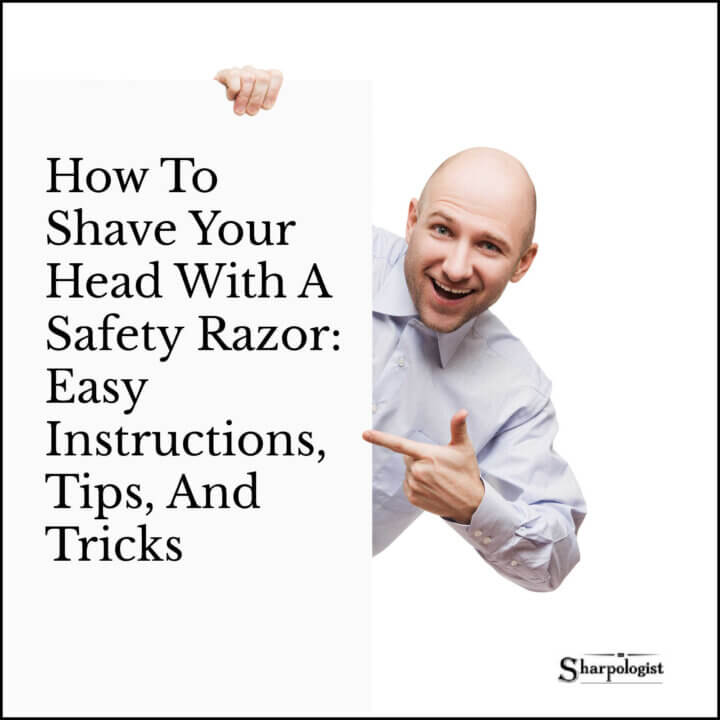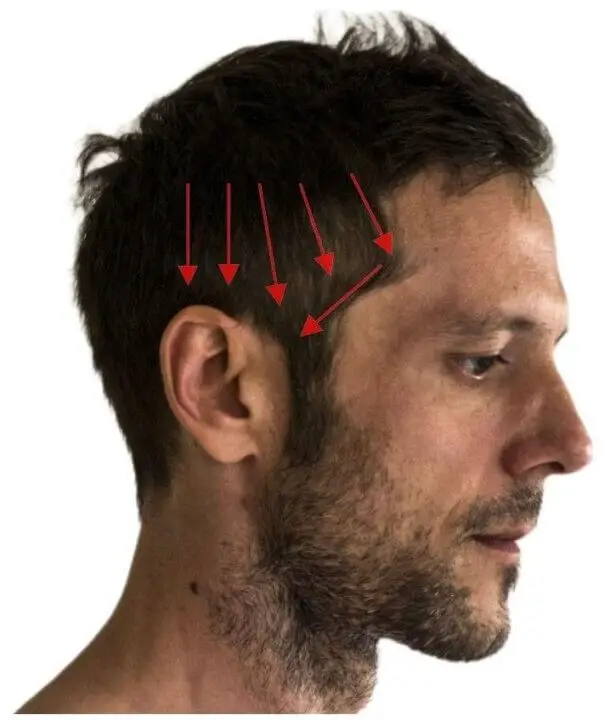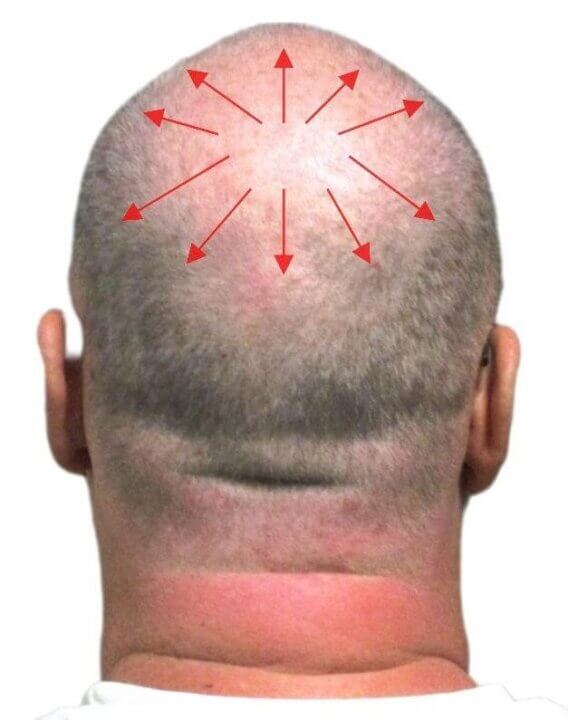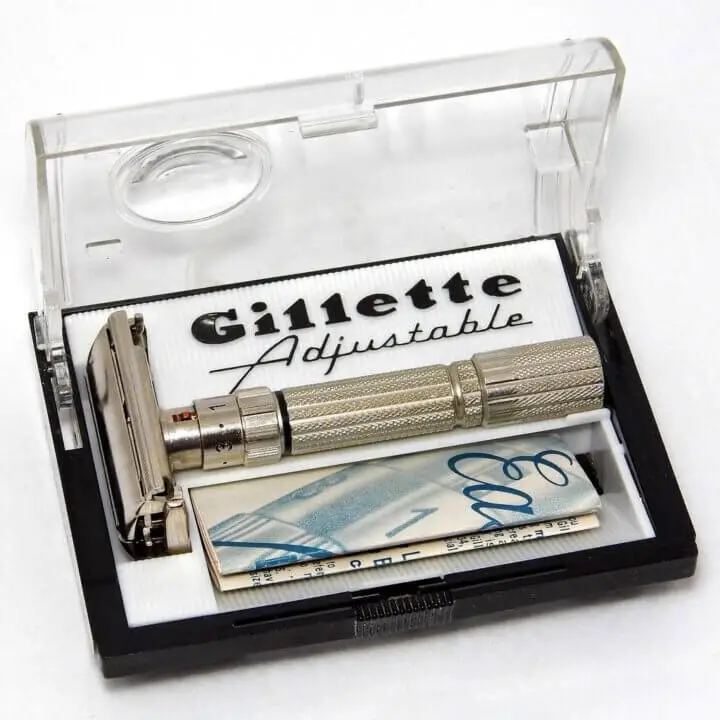
So recently your hairline receded to the point of annoyance, you’ve decided to remove your horseshoe, and proudly join the growing ranks of Boldly Bald Men. Or you might be going for a more popular, edgy look by growing your beard out but keeping your pate shorn close. You’ve also reckoned to reduce costs and environment impact, yet increase grooming fun and entertain a timeless shaving tradition. Then suffer no more! Welcome to the shiny new world of the safety razor head shave! In this article I will guide you forward to an effortless head shave with a traditional single-blade safety razor.
Preparation: Get your Skills Down
In preparation, focus first on becoming proficient in your face shaves with the double edge razor, then transition to a head shave in 4 or 5 easy steps. You will inevitably run into problems on the back side of your head by diving directly into a full head shave with your DE razor instead of easing into it. Remember the “6P” formula for success: proper prior planning prevents poor performance.
Map your growth:
Like your face, you must know which way your head hair grows. On the sides of your head, in front of your ears, the hair shafts above the cheeks mostly grow down towards your ears. Higher up, the hair grains slant down towards the eyes, or some combination of both. There are variances here depending on your particular growth patterns.

On the back of the head, the hair grows down, except at the nape of neck where it frequently slants down and aside towards the shoulder blades.

The crown of the head frequently sees hair shafts (or what is left of them as we age) growing or spiraling outward in a corona pattern.

Map your growth appropriately for your Against the Grain (A.T.G.) finishing pass for that baby-smooth finish.
The Best Time to Shave:
The proper time for a head shave mirrors that of your personal choice for a face shave: Whenever it best fits your schedule. Others have written about this elsewhere: https://sharpologist.com/when-is-the-best-time-to-shave-your-face/ Shave after a shower for the softest hair which is easier to cuti with a blade, and is also slightly elongated due to water absorption.ii Be forewarned that the post-shower ease of cutting hair also arrives hand-in-hand with more irritation of softer, moist skin.
If showering is not an option for you due to time or other constraints, you can instead wash your head with warm water or apply a warmed and damp towel for 2-3 minutes to soften the hair to have a similar effect.
Get your Skin in the Game:
Consider your skin sensitivity of your scalp. The skin on your head is more sensitive than that on your face, but less delicate than your neck region. Plan accordingly by applying pre-shave oil prior to the finish pass to reduce irritation.
Splitting Hairs:
Head hair is finer than that of facial whiskers, but there is massively more of it. Expect it to bunch up or clog your regular razor if you prefer mild razors with a slight blade gap and/or thinner shave creams. Work around this with a three-pass shave and more frequent razor rinsing, even if your typical shave routine is only one or two passes.
Let it go to your head.
Take it slow the first few times around and work in stages.
By which I mean: shave only what you can visibly see first, namely the sides of your head and maybe the frontal top areas only (if applicable). Bring the shave techniques you’ve mastered on your face and/or neck to these areas, and continue your normal head shave routine on the back and upper-rear areas of your skull until you are comfortable with the feel and performance of the bare blade on your braincase.
Next, as you gain more skill and comfort, gradually transition to the rear of the head. Hold the top of your ears down when you shave close to or above them, and pull the back of the ear forward when shaving behind the ear.
Feel your way forward:
You must master the “braille method” of checking your head shave results with a free hand. Take a few strokes with the razor in your dominant hand – 2 or 3 at most – then check the patch you just shaved with your opposing hand. Re-apply lather if you have to go over the same area again, and remember to keep light yet consistent pressure on the shaver. Buffing in these areas is also suggested provided you have the muscle-memory skill.
It is possible to shave your head fully without being ambidextrous, but to avoid injury, ensure you move your non-dominant hand out of the way after a progress check before resuming.
More enterprising head shavers could use a secondary mirror, or perhaps a camera / cell phone mounted on a tripod or back wall to check progress and overall results. As you gain more skill and confidence these technological aids can be set aside.
Should you find yourself constantly injuring your ears or the fingers of your “checking hand”, consider snapping the double edge blade in half and shaving with only one half of the razor blade in your shaver. This effectively turns your double edge shaver into a single edge, and makes working around the ears or in divots somewhat safer. Subie shows us how to do that at the video link here: https://www.youtube.com/watch?v=mco6vzFxQE8
Here, the extremely excited wet shaving advocate “Subie” will demonstrate a high-energy head shave using two different razors and split razor blades. He also has many previous full head shave videos demonstrating the Leaf, Twig or the Thorn for head shaves.
Until humanity evolves eyes on the back of our heads, this is your best path forward.
Choose Your Blade Wisely.
[Ed. note: Amazon links are affiliate.]
As you begin your first foray into the uncharted country of head shaving , you should feel free to use whatever razor you are most comfortable with in your daily routine.
If you’re looking for some specific advice click/tap here to read The Best Head Shaver Razor
If you are directly getting into head shaving with a double edge shaver, consider beginning with a mild shaver combined with a sharper blade, since this will grant you a more forgiving shave experience. For example, a Weishi, Henson or Mamba shaver combined with a Feather, Nacet, Bic, or Super Iridium blade will make for a promising start. The fusion of sharp blade / mild shaver also lies at the heart of the widely esteemed Feather AS-D2 razor, and can similarly be yours through the Timeless Slim edition razor. Other blades which are a touch milder are Voskhod, Astra Superior Stainless [blue], or Gillette Wilkinson Sword. Of course any blade which works best for you ought to be tried first, but keep an open mind to experiment if need be. (Please see my previous blog article on razor blade sharpness for further details.)

Alternatively, an adjustable double edge shaver – either Vintage Gillette or newer variety of another brand – will be your best friend as you venture forth on this new shaving adventure, since you can initially begin on a lower/milder setting and change accordingly as your shave progresses.
Post Shave Skincare:
When your head shave concludes, you must treat the freshly shorn skin with the same care as your face or neck gets relieved after you shave there. So at least for the first few times you do a head shave, use a good post shave balm from your favorite artisan until your skin “toughens up” a bit and you get your technique properly honed in. Thereafter you can switch to a regular aftershave splash. If you are outdoors during the summer months and/or you live in sunny climates close to the equator, consider applying a higher-SPF sunscreen when strolling out and about. Alternatively you could adorn yourself with a fashionable fedora, a fine fisherman’s cap or sensible beanie, or whatever you feel is befitting of a modern gentleman. Either way, take care to avoid acquiring a nasty sunburn on your noodle, which will make your next head shave a less-than-pleasurable experience.
Trade in your old model:
If you’re running into problems with the head shave taking too long or you frequently get injuries or irritation, consider the “cartridge-like” razor instead. The Leaf Razor – or perhaps the Shavent if you are in the E.U. – is well-loved in online shaving circles across the globe. I wrote a contrast and review article between these two wet shaving Titans earlier here. The newer Maxwell June razor also marries the convenience and comfort of a cartridge shaver with the sustainability and low cost-per-shave of the traditional double edge razor. Other suitable candidates include the Twig Razor, the Focus Dynamic R50, the OneBlade, the Challenger single-edge razor, and perhaps a few others. Any of the above may alleviate the hassles of shaving the hind portion of your head.
Make Minor Incremental Adjustments:
To apply a thought here from business and personal development thinker Brian Tracy, it will take between 3 to 6 tries acquiring any new skill before you truly become acclimated and comfortable with the new routine. I’ve found this to be true in car racing, life and shaving.
Likewise with another of my personal favorite sayings: All innovation is iteration.
A further pertinent thought regarding shaving is: Change only one variable at a time, then test several times.
These notions are doubly applicable here when initially stepping into head shaving and shaving in general. Whether you are diving into a new tub of shave soap with a freshly-developed soap base, trying out your latest razor acquisition, or testing the feel of a new blade brand, pledge yourself to change only 1 variable at a time and go through at least 3 or so shaves until you get the true feel of how it works for you. Then adjust another detail and repeat the process. Wash, shave, rinse and repeat. Changing too many things at once can lead to a poor or irritating shave and inspire you to halt your experiments right before you potentially strike the proverbial gold.
That’s the difference between throwing in the wet shave towel too early and settling for a predictable and clichéd shave routine vs. breaking through to a new way of getting better results with your personal grooming habits.
So don’t be a “Duke of Habit”. Experiment intelligently with the fine art of removing the hair from your head and you will succeed.
Some closing thoughts and well wishes.
In closing we at Sharpologist.com wish you the very best on the shaving journey ahead of you. We suggest a few videos to further speed you along your wet shave way:
While online video advice on head shaving abounds, here is a decent introduction to DE head shaving for novices: https://www.youtube.com/watch?v=mz27gupXhEg
https://www.youtube.com/watch?v=mco6vzFxQE8 .
Good luck, and may your lather never run dry.
P.S.: As a friendly word of general advice, please don’t drink and shave. I’ve done this inadvertently and it inevitably leads to choppy results. Use only one or the either at a time; let either the bare blade go to your head or the bracing beverage, but never both at once, especially when performing a head shave.
i https://archive.ph/2MXL4 “On the other hand, studies on shaving show that saturation in plain water results in about a 30% reduction in the force-to-cut beard hair. This is matched closely by the softening of the medulla from 0.35GPa to 0.26GPa. Since hardness is typically defined by the force to cut or indent, this data suggest that the softening of the medulla (and probably the cortex) is responsible for the bulk of softening of the beard, and is the main factor in using less force to cut your beard.”
ii https://www.ncbi.nlm.nih.gov/pmc/articles/PMC4387693/ “When wet, virgin hair can be stretched by 30% of their original length without damage…. Water absorption causes the hair shaft swelling.”
